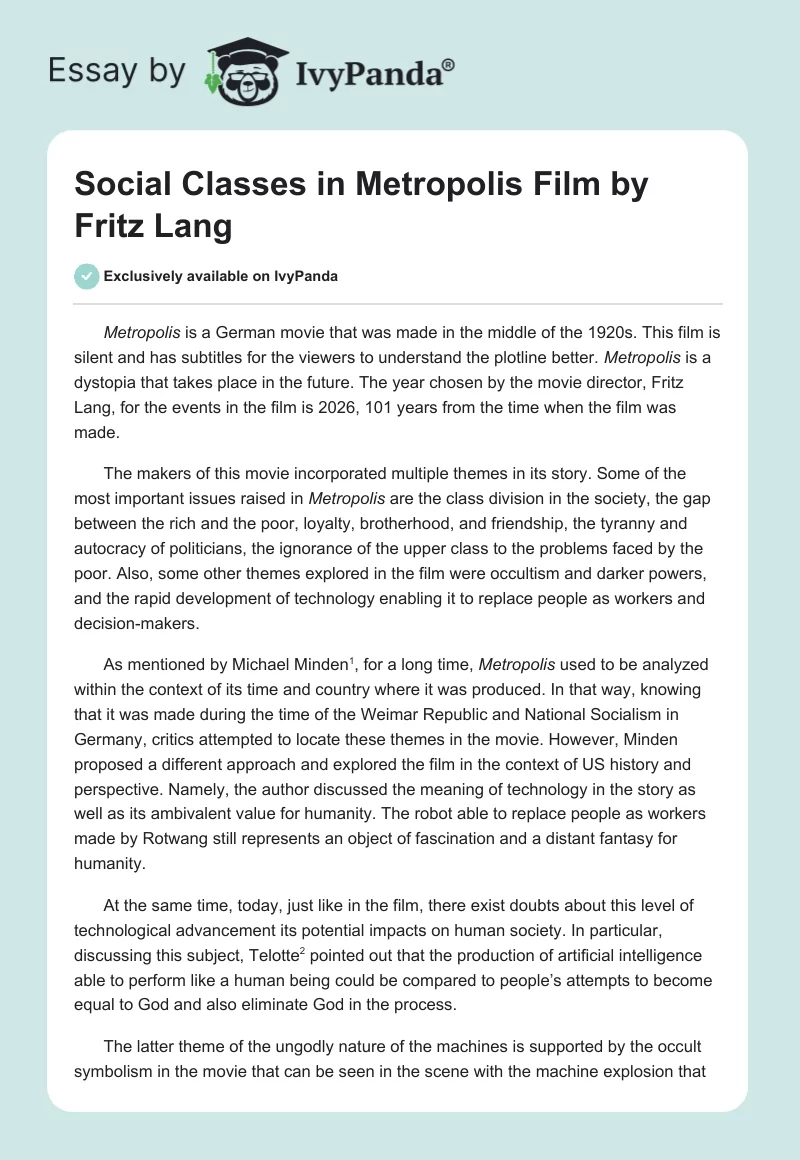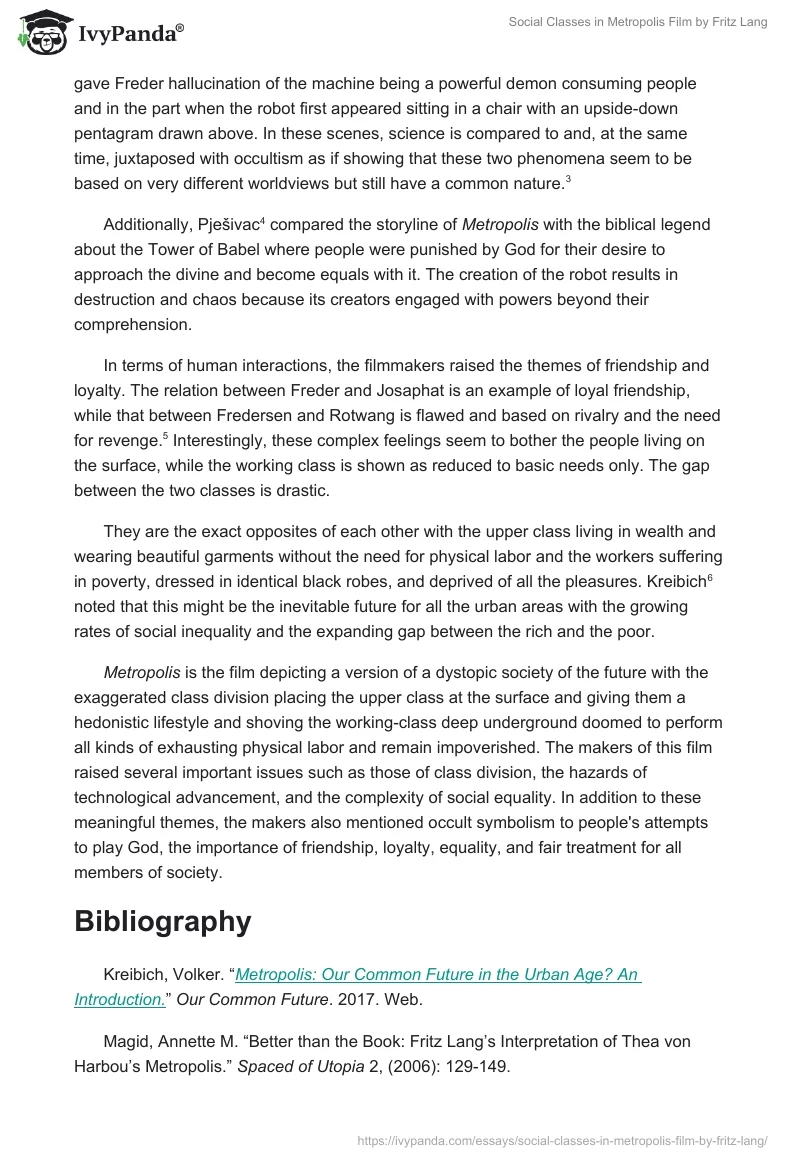Metropolis is a German movie that was made in the middle of the 1920s. This film is silent and has subtitles for the viewers to understand the plotline better. Metropolis is a dystopia that takes place in the future. The year chosen by the movie director, Fritz Lang, for the events in the film is 2026, 101 years from the time when the film was made.
The makers of this movie incorporated multiple themes in its story. Some of the most important issues raised in Metropolis are the class division in the society, the gap between the rich and the poor, loyalty, brotherhood, and friendship, the tyranny and autocracy of politicians, the ignorance of the upper class to the problems faced by the poor. Also, some other themes explored in the film were occultism and darker powers, and the rapid development of technology enabling it to replace people as workers and decision-makers.
As mentioned by Michael Minden, for a long time, Metropolis used to be analyzed within the context of its time and country where it was produced. In that way, knowing that it was made during the time of the Weimar Republic and National Socialism in Germany, critics attempted to locate these themes in the movie. However, Minden proposed a different approach and explored the film in the context of US history and perspective. Namely, the author discussed the meaning of technology in the story as well as its ambivalent value for humanity. The robot able to replace people as workers made by Rotwang still represents an object of fascination and a distant fantasy for humanity.
At the same time, today, just like in the film, there exist doubts about this level of technological advancement its potential impacts on human society. In particular, discussing this subject, Telotte pointed out that the production of artificial intelligence able to perform like a human being could be compared to people’s attempts to become equal to God and also eliminate God in the process.
The latter theme of the ungodly nature of the machines is supported by the occult symbolism in the movie that can be seen in the scene with the machine explosion that gave Freder hallucination of the machine being a powerful demon consuming people and in the part when the robot first appeared sitting in a chair with an upside-down pentagram drawn above. In these scenes, science is compared to and, at the same time, juxtaposed with occultism as if showing that these two phenomena seem to be based on very different worldviews but still have a common nature.
Additionally, Pješivac compared the storyline of Metropolis with the biblical legend about the Tower of Babel where people were punished by God for their desire to approach the divine and become equals with it. The creation of the robot results in destruction and chaos because its creators engaged with powers beyond their comprehension.
In terms of human interactions, the filmmakers raised the themes of friendship and loyalty. The relation between Freder and Josaphat is an example of loyal friendship, while that between Fredersen and Rotwang is flawed and based on rivalry and the need for revenge. Interestingly, these complex feelings seem to bother the people living on the surface, while the working class is shown as reduced to basic needs only. The gap between the two classes is drastic.
They are the exact opposites of each other with the upper class living in wealth and wearing beautiful garments without the need for physical labor and the workers suffering in poverty, dressed in identical black robes, and deprived of all the pleasures. Kreibich noted that this might be the inevitable future for all the urban areas with the growing rates of social inequality and the expanding gap between the rich and the poor.
Metropolis is the film depicting a version of a dystopic society of the future with the exaggerated class division placing the upper class at the surface and giving them a hedonistic lifestyle and shoving the working-class deep underground doomed to perform all kinds of exhausting physical labor and remain impoverished. The makers of this film raised several important issues such as those of class division, the hazards of technological advancement, and the complexity of social equality. In addition to these meaningful themes, the makers also mentioned occult symbolism to people’s attempts to play God, the importance of friendship, loyalty, equality, and fair treatment for all members of society.
Bibliography
Kreibich, Volker. “Metropolis: Our Common Future in the Urban Age? An Introduction.” Our Common Future. 2017. Web.
Magid, Annette M. “Better than the Book: Fritz Lang’s Interpretation of Thea von Harbou’s Metropolis.” Spaced of Utopia 2, (2006): 129-149.
Minden, Michael. “Fritz Lang’s Metropolis and the United States.” German Life and Letters, 3, no. 53 (2000): 340-350.
Pješivac, Željka. “Spaces of Territorialization in Fritz Lang’s Film Metropolis (1927).” Journal of Art and Media Studies, 7, (2015): 85-95.
Tängerstad, Erik. The Medieval in the Modern: The Cathedral and the Skyscraper in Fritz Lang’s Metropolis. Visby: Gotland University Press, 2012.
Telotte, J. P. Replications: A Robotic History of the Science Fiction Film. Chicago: University of Illinois Press, 1995.


